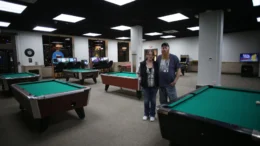Demolition work is continuing at the landmark Assumption BVM Church building on Oil City’s North Side.
A crew from BKI removed many of the windows from the church building and demolished the dome on Tuesday.
More windows were removed Wednesday as well as the bells from the belfry that was then demolished.
Objects considered sacred by the Roman Catholic Church such as alters, bells, stained glass windows with sacred images, statues, icons, sacred images and vessels can only be sold to another Roman Catholic church according to canon law, McElrath said.
He added that some of the items from Assumption have already been purchased.
The Oil Region Alliance had inquired about saving the bells and the dome, Jennifer Burden, the historic preservation staff member for the Alliance, said.
“The dome was the only thing that really stuck out. You could see it from Route 8 and other parts of the city,” Burden said.
She added the Alliance was told both were considered sacred objects that could not be sold. Burden said she was told the dome was considered a sacred object because it had a cross on top of it.
Other than that, Burden said that while some aspects of the building that weren’t considered sacred objects, such as the tin ceiling, were interesting, there was no way to meaningfully preserve them.
The interior, which was less ornate than many other churches, had been “renovated majorly” at some point and the windows had been replaced, Burden said.
The Erie Catholic Diocese spoke to several interested parties about the organ in the church but was unable to find a suitable buyer, McElrath said.
“The organ was a little too small for most churches with the financial means to install an organ,” said McElrath, who added it would have been expensive to rebuild the mechanical instrument.
“Often each organ is designed uniquely for the building, though that one looks like it may have been purchased from a catalog,” McElrath said.
“People took out second mortgages to build the church. They were poor but owned a house and didn’t know they were poor,” Frank Feroz, whose family had attended Assumption, said this week as he watched the belfry come down.
Feroz fondly recalled Masses at Assumption that were said in Polish.
Feroz went on to reminisce about a time when Assumption was at the center of the social life of Oil City’s Polish community.
The demolition is costing St. Joseph Parish $50,000, McElrath said. He added that once the building is gone the plan is to plant grass on the site.
“This (close and demolish a church) is not something you ever want to have to do,” McElrath said.
McElrath said the road to demolishing the church building was a long one that required specific procedures to be followed and a number of people in the parish and the diocese to sign off on it.
In February 2017, Assumption was merged into St. Joseph parish.
In July 2019, the church building was “relegated to profane but not sordid use” by the diocese.
The demolition of Assumption was announced in the the bulletin distributed at St. Joseph and St. Stephen churches the weekend of Oct. 4.
“We have made the difficult decision to demolish the former Assumption of the Blessed Virgin Mary Church,” the bulletin said. After discussions with several potential new owners, “we have been unsuccessful in finding a new owner for the former Assumption church building.”
The bulletin also cited “the precarious condition of the facility,” the parish’s “limited financial resources” and “the lack of use of the former church building for over a year now” as reasons to demolish the building.
Last year, the Oil Region Alliance funded a preservation plan for both the church and the nearby former Assumption school that houses the St. Elizabeth Center.
Besides issues that are typical of any building more than 100 years old, brick was falling out at one corner of the church, and there were issues with the metal ceiling on the inside of the church, Burden said.
One unexpected structural issue that came to light when the stations of the cross were removed was that major support beams had been notched to fit in the stations, Burden said. This further weakened the structural integrity of the building, she added.
“There has been a lot of heartache about this but it should come as no surprise,” Burden said. “It’s not as easy as just buying a property. There are a lot more stipulations such as taking out some of the windows,” she added.































